The hand that we will analyze today was played on the bubble: there are five people in the tournament, but only four receive prizes. We have the second stack and AKo. I want to analyze the situation in detail, show what we should do with our hand, and at the end tell how to work on understanding ICM. Go.
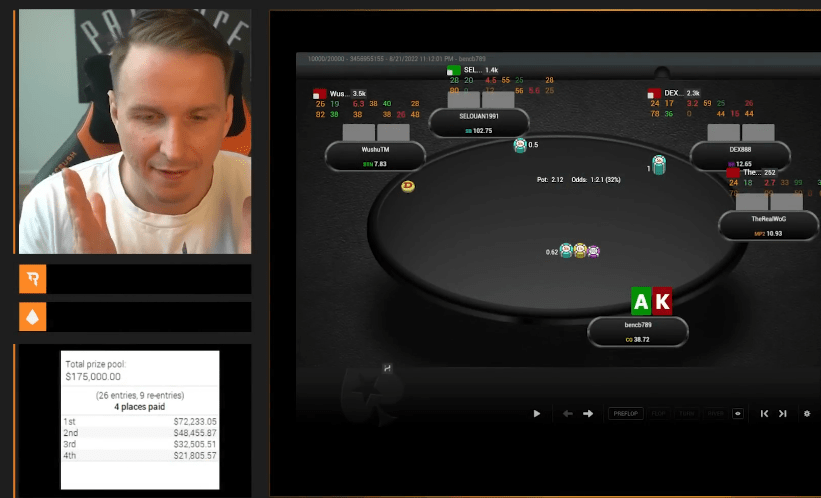
For starters, I don't think I need an open push range at all here. Risking 38 blinds for two big blinds? It's just not profitable. We don't want to go all-in even with aces or kings. Therefore, we open with a min-raise.
The chip leader pushes.
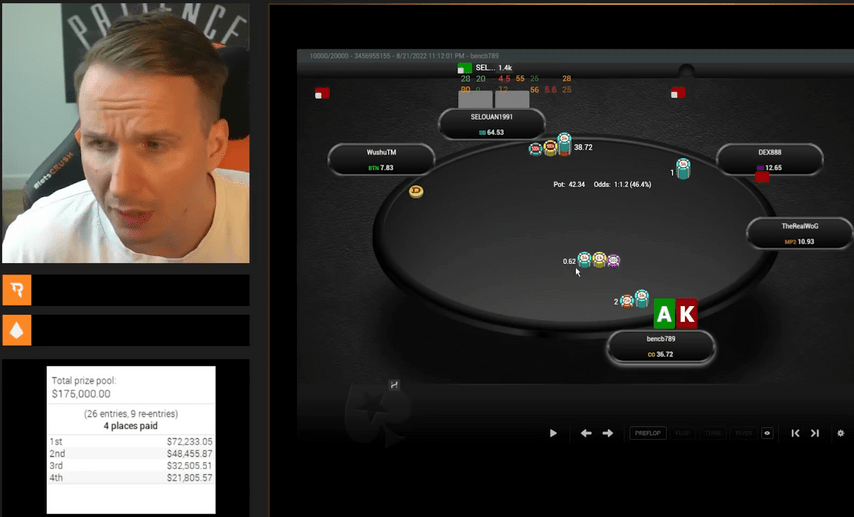
Good move – he should be all-in often to put maximum pressure on us. He does not elimination, but our situation is rather complicated. How would you play? Would you call with pairs of tens or higher? What about AQ? 88? Maybe you would only call with aces and kings?
Let's look at the other players first – it's pretty interesting to know what ranges they should be all-in with in this situation. Let's start with the player in first position.
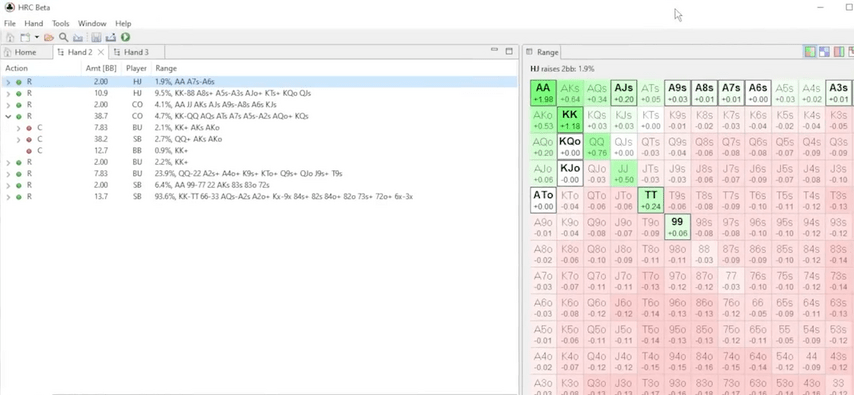
Even though he only has 11bb in his stack, he has some min-raise folds, which is pretty typical for a heavily ICM-influenced strategy – we try not to get too attached to the pot. Knowing about the existence of this line is very useful. His open pushing range is also quite narrow, less than 10%.
The reshoving and 3-betting ranges of other players in response to a min-raise look quite realistic.
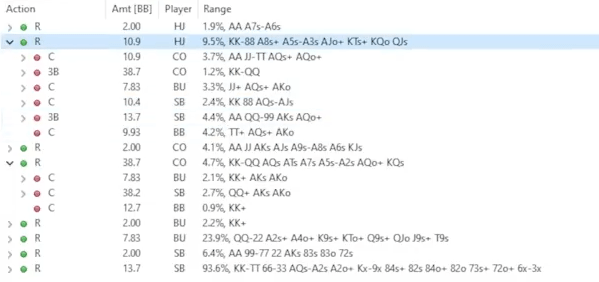
Personally, if I were him, I would focus on the most profitable pushes – AQ, AJs, KQs, pairs of tens or higher, raise-folded some suited Ax and set traps with aces and kings. Something like this. If the opponents made it clear that they do not respect my min-raises at all, I would add some suited Ax into an all-in range.
We in the cutoff should open quite narrowly.
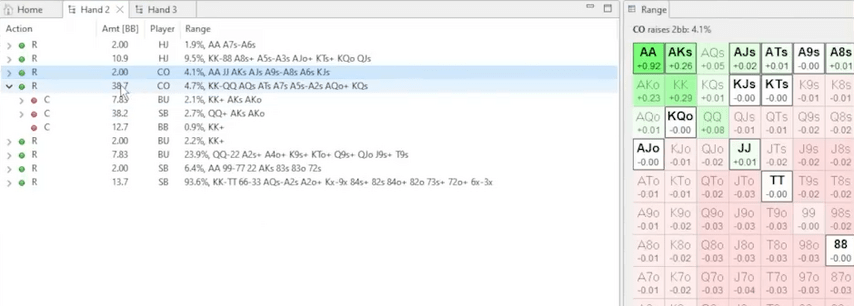
Among other things, our folding forces WushuTM, who has a stack of less than 8bb, to go all-in frequently and risk busting. Approximately 25% of his hands go all-in!
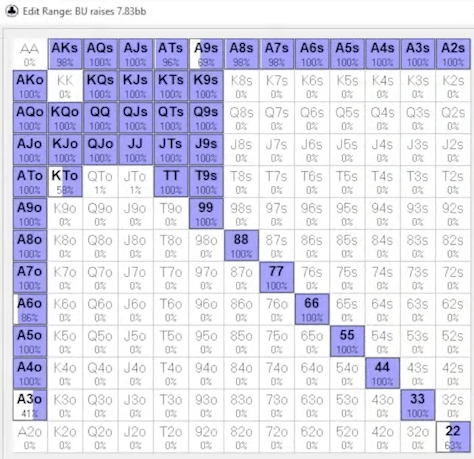
And this is very important to us. We would be terribly happy to finish the bubble as quickly as possible, because ICM is very restrictive. So we don't want to open something like KTo. We are not interested in stealing the blinds at all! The priority is to give other players a chance to take out each other.
By the way, even with a WushuTM microstack there is a min-raising range!
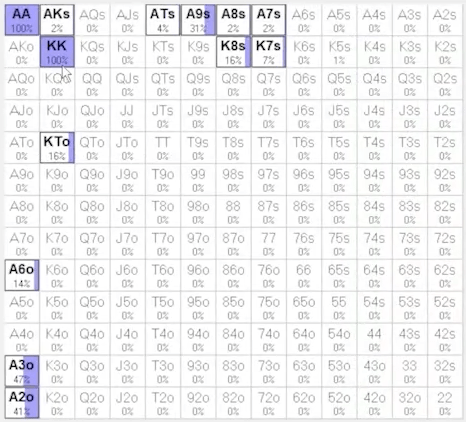
Min-raise calls are easy to spot, and min-raise folds are made with hands from the bottom of a shoving range.
Yeah. But many people think that with ten big blinds, any raise commits to the pot! But when ICM comes into play, everything changes.
The solver, by the way, says we should have a shoving range. I still don't like this idea.
Here's how wide the small blind can shove to our min-raise.
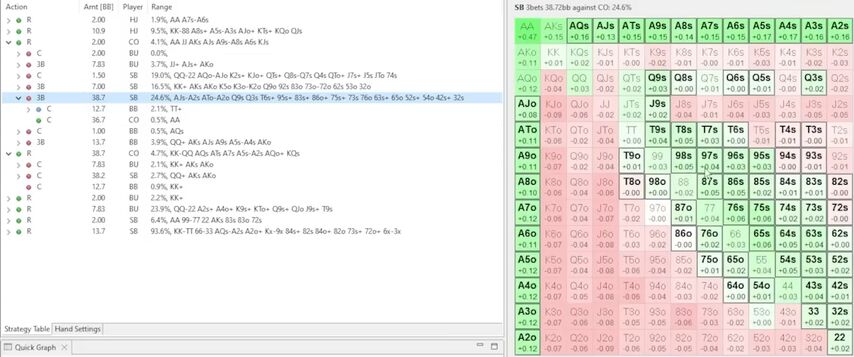
Madness!
Why doesn't he want to push king hands other than KQs? Because we have a lot Kx in the raise fold range.
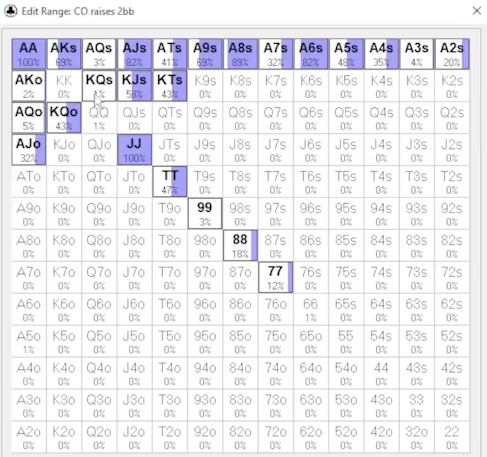
We open KQo, KJs and KTs and of course we don't pay all-in with them. Each king in SB's hand blocks a significant proportion of these combos. But the AQs solver in our place wants to shove, so the presence of a queen in the small blind is not a negative.
Still, his shoving range is kind of wild. That's what ICM is! And the explanation is very simple: our calling range...
...that's strictly aces!
Here is such a wild bubble: the min cash is four buy-ins, and there are three short stacks at the table. This is an MTT, but the situation is as similar as possible to a satellite.
If you play tournaments with a small number of participants and are fighting for a prize of two or three buy-ins, you often find yourself in similar situations due to ICM.
Personally, if I were the small blind, I wouldn't shove that wide. Rather, instead of all-ins, I would bet a huge number of 3-bets. In my opinion, this is much better.
Look again at the expectation of his all-ins – many hands have very marginal expectations. And if the opponent starts calling not only with aces, but at least with kings, queens and AKs, marginal pushes will turn into terrible ones. You don't need a degree to understand this. And even I, although I worked a lot with ICM, in this situation could not throw out the kings. Unfortunately – because it is worth a little thought, and you understand that it is completely unprofitable for me to be all in with KK against A5s, and all these 65v35 and 70v30 are pretty sad for me. This is a crash every third hand, while folding can get you to the money 99% of the time.
In general, don't make blunders and never call here with AKo!
One more question. We min-raised, the chip leader shoved – what range should DEX888 call in the big blind?
The solver answers – with any pair of tens and above. And this is very logical, because we fold almost all hands, and there is a lot of dominated garbage in the shoving range of the chip leader. Short stack players can afford and even have to play quite loosely.
If everyone folds before the chip leader, he goes all-in with any two cards. Nothing surprising! It's funny to note that pushing with 32o has almost the same expectation as pushing with AA.
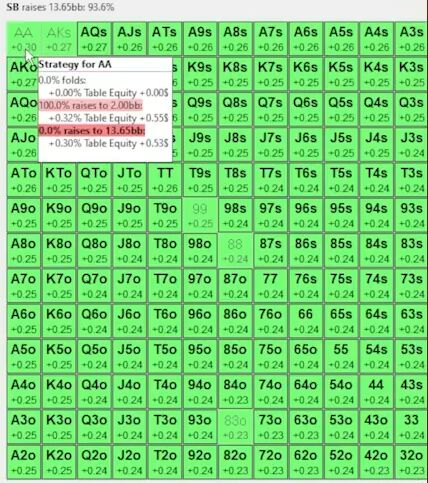
The big blind defends very narrowly – only with 99+. The profitability of the chip leaders shove comes from fold equity.
Of course, our decisions in this hand were greatly influenced by the presence of three short stacks. To get a deeper understanding of the logic of the game, let's subtract 30 blinds from the chip leader and add ten to each of the shorts.
What will happen? There will be a chip leader with about 70bb, three players with comfortable stacks of 20-30 blinds, and we still have the same 38 blinds. What has changed? Let's try to figure it out without a solver first.
If we play as tight as in the previous example, it will lead to big chip losses, and there is no guarantee of hitting the money. It will be a long time before someone is in the danger zone. With such stacks, you shouldn't wait for open-pushing, re-pushing after raises is much narrower, and you need a very severe cooler to get out. The bubble is threatening to drag on. Unless, of course, everyone plays more or less correctly. We'll just lose chips, and when someone busts, we'll only have 10-15 blinds left.
Therefore, you need to press the gas pedal. Here is our min-raising range:
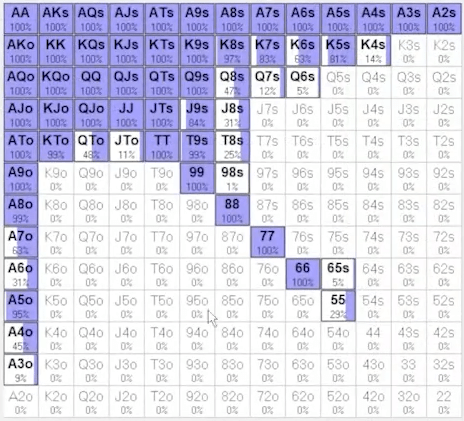
Compare with the previous example. Now we can play a lot looser because the small blind re-raises a lot tighter, because we are ready to call his shoves not only with aces:
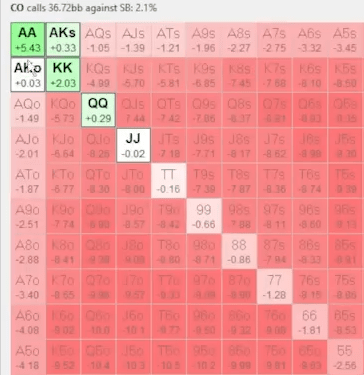
It is always beneficial for the chip leader to keep the bubble going as long as possible. When there are three players with 10bb stacks in the game, this factor is not so important, because statistically the bubble cannot last long. Therefore, it is not so great for us to double, because then there will still not be enough time to realize the advantage gained. It's a different matter when we change from short stacks to comfortable ones: now doubling will give us much more potential later in the game. An extremely important concept for understanding tournament strategy!
So, with a more even stack distribution, we should open wider and call all-ins wider. The absence of a player with 5-10bb gives us more freedom.
What I have just done is a very useful technique, a fundamentally correct way to study MTTs. Did you run a hand? Now play with the stacks of players and see how the strategy of each of the participants in the hand changes. Just now we could only call a shove with aces, and now we have a call with AKo! Great! By the way, I think that in the second case, most players with AKo will throw it away. Tournament bubble, we have a second stack, like a simple pass to the ICM? It turns out not! All this is very, very important.
Of course, we looked at a bubble in a tournament with a small number of players. In large fields, the situation will be quite different. When there are a hundred people in the prizes, doubling on the bubble has almost no effect on the probability of an overall victory – it grows by 1-2%, no more. And in a small tournament, doubling up on the bubble significantly changes our chances of first place, because our share of the prize pool will increase dramatically.
ICM always compares what you risk with what you can gain. Calling all-in on the bubble of a small tournament carries very high risks, but the reward is also great. In the top 90, the reward is almost imperceptible.
This is even more pronounced in mass tournaments like the Sunday Storm. They don't really benefit from doubling up on the bubble, whether you have 20bb, 15bb or 10bb. You just want to get into the prizes.
That, in general, is all that I wanted to tell about this hand. In the tournament, of course, I folded. The decision itself is not particularly difficult, but it is important to correctly understand the situation at a strategic level, and that is what my video was about.











